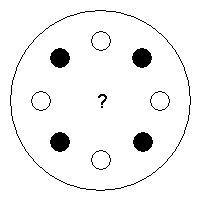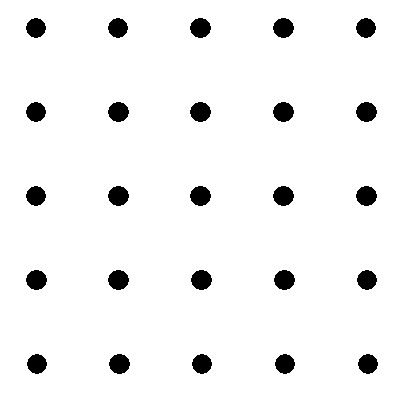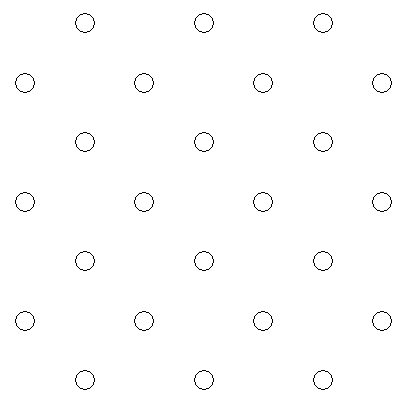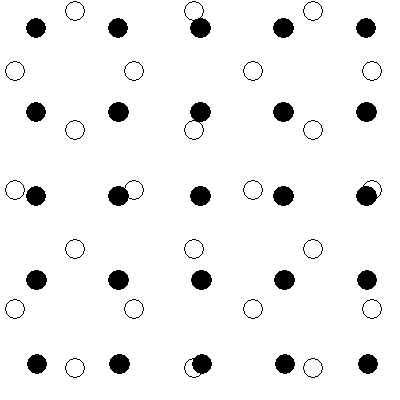Why is Roto-Inversion Symmetry so Complex?
Steven Dutch, Professor Emeritus, Natural and Applied Sciences, Universityof Wisconsin - Green Bay
As explained in the page on three-dimensional symmetry,there's a close link between the seven strip space groups and the seven types ofthree dimensional symmetry we can have around a single symmetry axis. If we wrapa strip around a cylinder, we get something with three-dimensional rotationalsymmetry. But life gets complicated when we come to strips with glide symmetry.The corresponding symmetry is called roto-inversion symmetry.

Above at left we see a strip with glide symmetry wrapped around a cylinder.On the right is a solid (not a possible crystal form) with the same kind ofsymmetry. It has faces in green alternating with mirror-image faces in yellow.There are ten sides on the top, but only five of each kind of side face, so thesolid has five-fold symmetry. There are five faces pointing up and five pointingdown.
So we might expect that n-fold roto-inversion symmetry results in n faces onthe upper half of a crystal alternating with n mirror image faces on the bottomhalf. Can it really be so simple? You wish.
To see what really happens, let's compare a diagram of the symmetry with whatactually happens in the crystal on the atomic level. On the left below is whatwe might expect for one-fold inversion symmetry. Our strip has only onerepetition of its basic motif, with a mirror-image of the motif translated byhalf a unit. If we wrap the strip around a cylinder, we expect a motif on oneside and its mirror image diametrically opposite, as shown at left below.

Now let's see if we can actually make a crystal with this symmetry. The dot on the diagram above corresponds to the point where some face touches an imaginary sphere. If we look at some plane in the upper half of the crystal, it will cut the face along some row of atoms (shown connected by red lines at center). That means that in the lower half of the crystal there must be a corresponding row of atoms on the other side (green lines). We can easily construct a parallelogram lattice to contain these rows. It all works. It is, in fact, correct. |

Now let's try two-fold symmetry. We naively expect two dots (corresponding to faces) above alternating with two below. In the center we again show the rows of atoms corresponding to some plane cutting the upper half of the crystal. The rows of atoms in the upper half of the crystal are shown with red lines. Ninety degrees away, on the lower half of the crystal, we'd expect to find the rows shown in green. If the faces really are related by symmetry, the atomic arrangements and spacings on each face must be identical. This is a physically possible arrangement, but the unit cells must be square. This pattern represents four-fold symmetry, not two-fold! |

Okay, what happens if we try to create a pattern with four faces above alternating with four below? Obviously the atoms have to be arranged in a square pattern. A plane cutting the upper half of the crystal would cut four crystal faces as shown at right by the red lines. We can find rows of atoms 45 degrees away in the lower half of the crystal, but the spacings of the atoms are different. This is not a possible crystal symmetry. Although you can definitely make a crystal with faces oriented as shown, the faces in the upper and lower halves of the crystal have different atomic arrangements and are not related by symmetry! |
Why It's Not a Permissible Symmetry
 |
At first glance, this looks like it ought to be a perfectly possible tetragonal symmetry. |
 |
When we create a lattice corresponding to the solid (upper) dots, it's a perfectly possible tetragonal lattice. |
 |
Likewise, a lattice corresponding to the open (lower) dots is a perfectly possible tetragonal lattice. |
 |
The crunch comes when we try to combine the two layers, as would happen in a real crystal. The two layers cannot match up. This is not a valid crystal symmetry. It is, in fact, eight-fold rotoinversion. This example illustrates why the concept of rotational reflection was unsatisfactory. |
Return to Symmetry Index
Return to Crustal Materials (Mineralogy-Petrology) Index
Go to Recreational Mathematics Index
Return to Professor Dutch's Home Page
Created 9 Oct 1997, Last Update 9 Oct 1997